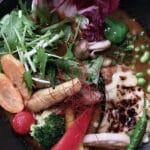Take a rich chicken bone stock and toss in a handful of whole ground spices and herbs. Add a whole chicken leg, braised until the meat is almost sliding off the bone. Slip in a bouquet of cooked vegetables – the bare minimum being carrot, broccoli, bell peppers, eggplant and potato – and serve alongside rice.
This is a classic Hokkaido soup curry, a spicy, vibrant soup-and-rice dish guaranteed to warm even the cold, dead bodies of your enemies. But this isn’t its final form. Like the Choose Your Own Adventure books of the 1980s, you can customize almost every aspect of your bowl. Add or subtract toppings, make it more or less spicy, and even change the broth base – at a soup curry restaurant, you’re the master of your own happy ending.
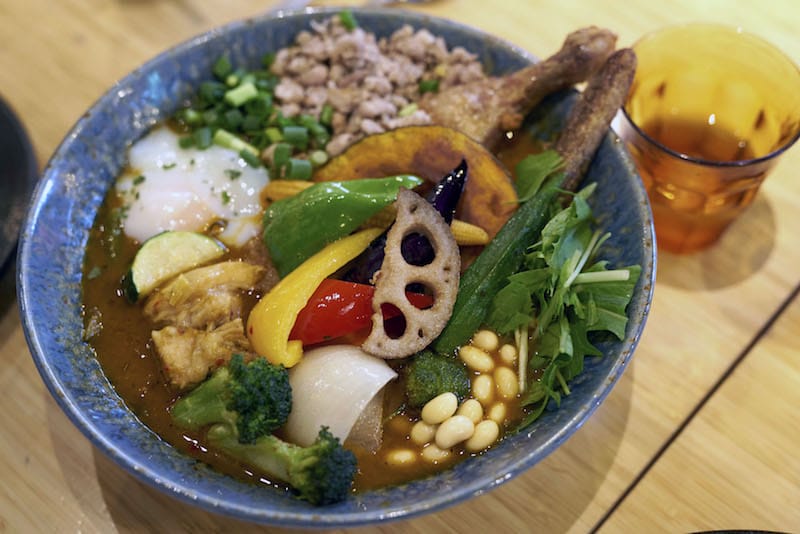
Being a relatively recent culinary invention, soup curry’s origin story is relatively straightforward, beginning in 1971 at Ajanta, a little coffee shop in Sapporo City, Hokkaido prefecture. The story goes that the late owner Muneo Tatsujiri was looking for a dish to bolster his and his father’s health, and after much tinkering in the kitchen, he hit upon the idea of combining Indian spices and Chinese medicinal herbs in a rich chicken-and-vegetable broth. According to Ajanta’s website, as many as 30 different spices and 15 Chinese herbs go into their soup recipe today.
After one of his regulars asked to try the soup, Tatsujiri added it to the cafe menu, serving 20 bowls a day with rice. Initially, he would discard the chicken and vegetables after straining the broth, but ceased the practice after a regular begged Tatsujiri to let them eat the meat and vegetables instead. In 1975, the cafe then began serving what would become the prototype for contemporary soup curry: a spiced soup with a whole chicken leg and other vegetables alongside a plate of rice.
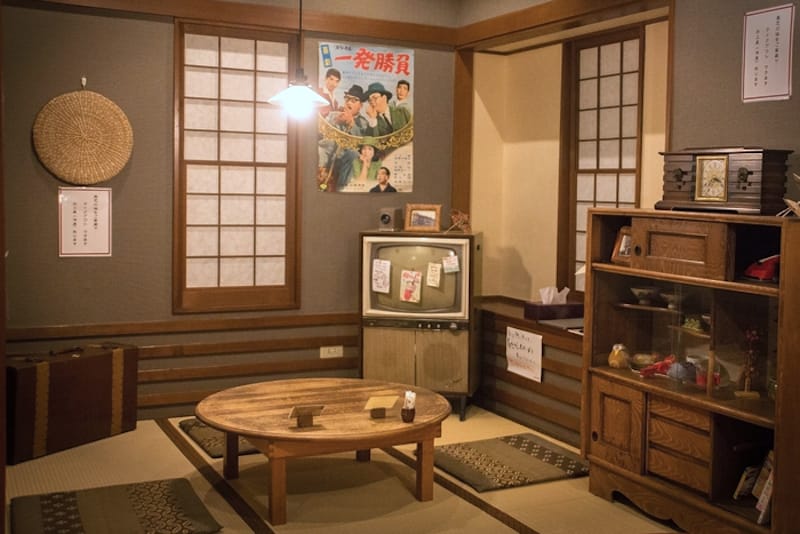
Other restaurants in Sapporo came up with their own versions, which were given names like “medicinal curry,” “Sri Lankan curry” or “Indian curry.” (It should go without saying that the dish is neither Indian nor Sri Lankan.) The name “soup curry” was not widely adopted until 1993, when the owner of the newly-opened Magic Spice Sapporo bestowed it upon their version of the dish, for which they took inspiration from soto ayam (an herbal Indonesian soup of turmeric, chicken and noodle).
Soup curry would remain a rather minor dish until the 2000s, when Magic Spice opened a branch at the now-shuttered Yokohama Curry Museum, a food theme park/museum that showcased the history of curry as it developed during the turn of the century in Japan. They hosted dozens of curry shops from across the nation in a central food court. Soup curry was a hit, sparking a boom and a flurry of restaurant openings centered on the dish nationwide.
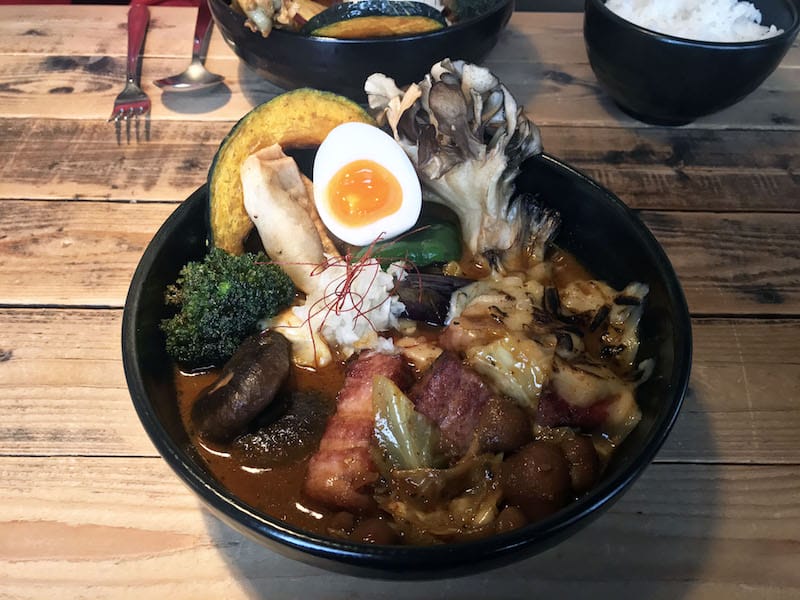
There are as many versions of soup curry as there are restaurants, but it’s always easily recognizable. It relies on the meat-based stock – chicken, pork, beef, veal, lamb or any combination thereof – and taste-wise, soto ayam is a good comparison: salty, savoury, meaty, herbal and spicy. Unlike regular Japanese-style curry, it isn’t thickened with roux. The emphasis is on its soupiness. Although tomato is a common addition to soup bases, soup curry is almost never tart or acidic; imagine the depth of rasam minus the tamarind. It is most emphatically not vegetarian, although some restaurants offer a dashi (skipjack bonito broth) base, which results in a lighter soup, while other possible bases include prawn, tomato and more rarely, coconut. (Ask your server whether it contains any form of meat or fish; as we mentioned, we haven’t encountered one that’s genuinely vegetarian so far.)
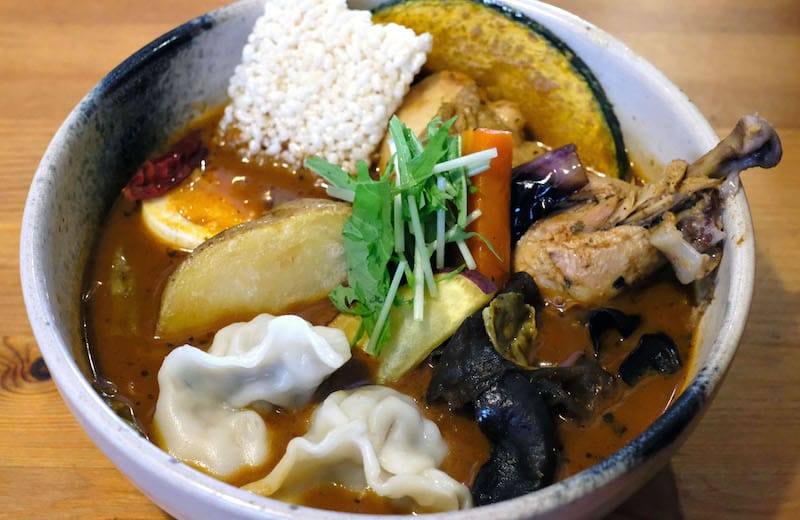
A friend once told us that she’d never met a soup curry she didn’t like. She unwittingly captured the spirit of this dish: With its hot spiced meat broth and vegetables, it’s quite difficult to go wrong. That said, some versions are better than others. A good restaurant like Rojiura Samurai (we tend to frequent the Shimokitazawa branch) will cook each vegetable separately rather than boiling the lot – for instance, they might deep-fry the eggplant, char-grill the broccoli and okra, blanch the sweet peas and baby corn, and roast the potatoes. They’ll pay attention to seasonal vegetables so the soup tastes different year-round.
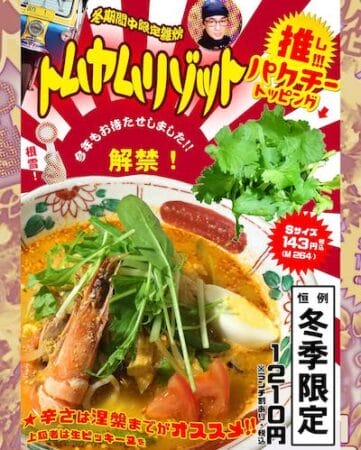
You might have a limited number of toppings to choose from – bacon, onsen tamago (hot spring eggs), melted cheese, fried chicken, extra vegetables – or the options might be as outré as natto (fermented soybeans), Camembert and seaweed paste, as they are at the super-psychedelic Magic Spice, also located in Shimokitazawa, the unofficial curry capital of west Tokyo. We are limited only by our imagination – and appetite for cartilage, snow fungus or rice cakes. (Magic Spice is an absolute trip: check out their website for a taste.)
At one of our favorite spots, Okushiba Shoten (we like the Katakura branch in Hachioji), each bowl is custom-made from scratch, with freshly-toasted spices for each serving. The wait is at least 15 to 30 minutes: Worth it, especially for the velvety shrimp base for the soup.
But really, we’ll take any bowl of Hokkaido soup curry. We have yet to choose an adventure we didn’t like.
Florentyna LeowFlorentyna Leow
Published on January 26, 2022
Related stories
January 9, 2023
Tokyo | By Florentyna Leow
TokyoTake a rich chicken bone stock and toss in a handful of whole ground spices and herbs. Add a whole chicken leg, braised until the meat is almost sliding off the bone. Slip in a bouquet of cooked vegetables – the bare minimum being carrot, broccoli, bell peppers, eggplant and potato – and serve alongside…
April 25, 2024
Tokyo | By Florentyna Leow
TokyoIt snowed in Tokyo on March 22 – a wet, rain-like snow that puddled as soon as it touched the ground, but snow nonetheless. It was un-springlike as the week before was sunny. Early spring is sly and tricky here. One moment the kawazu-zakura have blanketed trees in pink popcorn blooms, the next moment it’s…
February 28, 2024
Food Tours NDQuick Bite: This full-day Istanbul market tour draws from our best-of list in the European side’s Karaköy neighborhood and the Asian Kadıköy, tied together by a Bosphorus crossing, visiting two markets on two continents. Our favorite Istanbul experiences include exploring the eateries in local markets and crossing the Bosphorus on the public ferry. The route for…













































